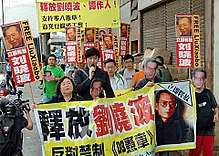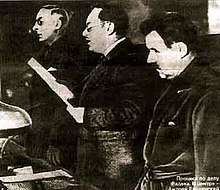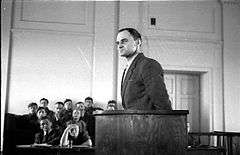Show trial

A show trial is a public trial in which the judicial authorities have already determined the guilt of the defendant. The actual trial has as its only goal the presentation of both the accusation and the verdict to the public so they will serve as both an impressive example and a warning to other would-be dissidents or transgressors. Show trials tend to be retributive rather than corrective and they are also conducted for propagandistic purposes. The term was first recorded in the 1930s.[1]
China

Following the formation of the People's Republic of China in 1949, the Communist Party of China under Mao Zedong began a massive socioeconomic and political campaign called the Great Leap Forward, which lasted circa 1958–1961. During this time, many thousands of people classified as elements of the bourgeois like wealthy landlords were rounded up, given show trials, with some receiving executions.
Between 1 and 2 million landlords were executed as "counterrevolutionaries" in Communist China.[2]
After the Tiananmen Square protests of 1989, show trials were given to "rioters and counter-revolutionaries" involved in the protests and the subsequent military massacre.[3]
Chinese Nobel Peace Prize laureate Liu Xiaobo was given a show trial in 2009.[4]
Chinese writer and dissident Ma Jian argued that Gu Kailai, the wife of purged Communist Chinese leader Bo Xilai, was given a show trial in 2012.[5]
Egypt
The United Nations human rights office[6] and various NGOs[7] expressed "deep alarm" after an Egyptian Minya Criminal Court sentenced 529 people to death in a single hearing on 25 March 2014. The judgment was condemned as a violation of international law.[8] By May 2014, approximately 16,000 people (and as high as more than 40,000 by one independent count)[9] have been imprisoned after the 2013 Egyptian coup d'état in July 2013.[10] Egypt's ousted President Mohamed Morsi was sentenced to death on 16 May 2015, along with 120 others.[11]
Turkey
After the failed coup attempt in 2016, the government of Turkey blamed the Gülen movement for the coup and authorities have arrested thousands of soldiers and judges.[12] This was followed by the dismissal, detention or suspension of over 160,000 officials.[13]
Soviet Union

As early as 1922, Lenin advocated staging several "model trials" in Soviet Russia and the Soviet Ukraine.[14]
Show trials were a significant part of Joseph Stalin's regime. The Moscow Trials of the Great Purge period (1937–38) in the Soviet Union are characteristic.
The Soviet authorities staged the actual trials meticulously. If defendants refused to "cooperate"—i.e., to admit guilt for their alleged and mostly fabricated crimes—they did not go on public trial, but suffered execution nonetheless. This happened, for example during the prosecution of the so-called Labour Peasant Party, a party invented in the late 1920s by the OGPU, which, in particular, assigned the notable economist Alexander Chayanov (1888-1937, arrested in 1930) to it.
Some solid public evidence of what really happened during the Moscow Trials came to the West through the Dewey Commission (1937). After the collapse of the Soviet Union (1991), more information became available. This discredited the New York Times reporter Walter Duranty, who claimed at the time that these trials were actually fair.
According to declassified Soviet archives, with documents dating to 1937 and 1938, the NKVD arrested more than one and a half million people, resulting in 681,692 executions.[15]
Eastern Europe

Following some dissent within ruling communist parties throughout the Eastern Bloc, especially after the 1948 Tito–Stalin split,[16][17] several party purges occurred, with several hundred thousand members purged in several countries.[16][18] In addition to rank-and-file member purges, prominent communists were purged, with some subjected to public show trials.[18] These were more likely to be instigated, and sometimes orchestrated, by the Kremlin or even Stalin himself, as he had done in the earlier Moscow Trials.[19]
Such high-ranking party show trials included those of Koçi Xoxe in Albania and Traicho Kostov in Bulgaria, who were purged and arrested.[17] After Kostov was executed, Bulgarian leaders sent Stalin a telegram thanking him for the help.[19] In Romania, Lucreţiu Pătrăşcanu, Ana Pauker and Vasile Luca were arrested, with Pătrăşcanu being executed.[18]
Yugoslavia
Hungary
Stalin's NKVD emissary coordinated with Hungarian General Secretary Mátyás Rákosi and his ÁVH head the way the show trial of Hungarian Foreign Minister László Rajk should go, and he was later executed.[19]
Czechoslovakia
The Rajk trials in Hungary led Moscow to warn Czechoslovakia's parties that enemy agents had penetrated high into party ranks, and when a puzzled Rudolf Slánský and Klement Gottwald inquired what they could do, Stalin's NKVD agents arrived to help prepare subsequent trials.
The Czechoslovak Communist party subsequently arrested Slánský himself, Vladimír Clementis, Ladislav Novomeský and Gustáv Husák (Clementis was later executed).[18] The Slánský show trial began. Slánský and eleven others were convicted together of being "Trotskyist-zionist-titoist-bourgeois-nationalist traitors" in one series of show trials, after which they were executed and their ashes were mixed with material being used to fill roads on the outskirts of Prague.[18] By the time of the Slánský trials, the Kremlin had been arguing that Israel, like Yugoslavia, had bitten the Soviet hand that had fed it, and thus the trials took an overtly anti-Semitic tone, with eleven of the fourteen defendants tried with Slánský being Jewish.[20]
The Soviets generally directed show trial methods throughout the Eastern Bloc, including a procedure in which confessions and evidence from leading witnesses could be extracted by any means, including threatening to torture the witnesses’ wives and children.[21] The higher-ranking the party member, generally the more harsh the torture that was inflicted upon him.[21] For the show trial of Hungarian Interior Minister János Kádár, who one year earlier had attempted to force a confession of Rajk in his show trial, regarding "Vladimir" the questioner of Kádár:[21]
| “ | Vladimir had but one argument: blows. They had begun to beat Kádár. They had smeared his body with mercury to prevent his pores from breathing. He had been writhing on the floor when a newcomer had arrived. The newcomer was Vladimir’s father, Mihály Farkas. Kádár was raised from the ground. Vladimir stepped close. Two henchmen pried Kádár’s teeth apart, and the colonel, negligently, as if this were the most natural thing in the world, urinated into his mouth. | ” |
The evidence was often not just non-existent but absurd, with Hungarian George Paloczi-Horváth’s party interrogators delightedly exclaiming "We knew all the time—we have it here in writing—that you met professor Szentgyörgyi not in Istanbul, but in Constantinople."[20] In another case, the Hungarian ÁVH secret police also condemned another party member as a Nazi accomplice with a document that had actually been previously displayed in glass cabinet of the Institute of the Working Class Movement as an example of a Gestapo forgery.[20] The trials themselves were "shows", with each participant having to learn a script and conduct repeated rehearsals before the performance.[20] In the Slánský trial, when the judge skipped one of the scripted questions, the better-rehearsed Slánský answered the one which should have been asked.[20]
Romania
As the end of the 1989 Romanian Revolution neared, First Secretary of the Communist Party Nicolae Ceaușescu and his wife Elena were condemned to death and shot dead by a firing squad after a Stalinist-style trial in a kangaroo court.[22]
Western Europe
- The Cadaver Synod was the posthumous trial of Catholic Pope Formosus held in 897.
- The Dreyfus affair was a show trial in France in 1894, where a Jewish captain, Alfred Dreyfus, was accused and convicted of spying for the German Empire and exiled.
- The Kapenguria Six were leading Kenyan nationalists who were subjected to a show trial by the British in 1952–53, and imprisoned thereafter in Northern Kenya.
Nazi Germany
Between 1933 and 1945, the Nazi government established a large number of Sondergerichte that were frequently used to prosecute those hostile to the regime. The People's Court was a kangaroo court established in 1934 to handle political crimes after several of the defendants at the Reichstag fire Trial were acquitted. Between 1933 and 1945, an estimated 12,000 Germans were killed on the orders of the "special courts" set up by the Nazi regime.[23]
See also
- 1415 trial of Jan Hus, Konstanz
- 1431 trial of Joan of Arc, Rouen
- 1649 trial of Charles I of England (by the High Court of Justice for the trial of Charles I)
- 1792 trial of Louis XVI during the French Revolution
- 1894 Trial of the Thirty, Paris
- 1946 Trial of Mihailović et al and execution, Belgrade, under Yugoslav communist regime
- 1948 trial and execution of Shafiq Ades, Iraq
- 1949 show trial and execution of László Rajk, under Hungary's communist regime
- 1953 Stalinist show trial of the Kraków Curia, Poland
- 1981 trial of the Gang of Four in China
- 1984 televised trial and execution of Al-Sadek Hamed Al-Shuwehdy in Libya
- 1989 Trial of Nicolae and Elena Ceaușescu and execution
- 2009 Iran poll protests trial of over 140 defendants
- The Trial of Saddam Hussein
- 2009 (June 4) trial of Euna Lee and Laura Ling in North Korea
- Eastern Bloc politics
- Kangaroo court: a sham legal proceeding
- NKVD troika, sentencing by extrajudicial commission
- Political trial, a criminal trial with political implications.
- Posthumous trial
- Witch-hunt, hunting down people of a certain race/trait/profession/political conviction for doing or saying something sinful
Notes
- ↑ OED (2014): "show trial".
- ↑ Busky, Donald F. (2002). Communism in History and Theory. Greenwood Publishing Group. p.11.
- ↑ Show Trials in China: After Tiananmen Square, Mark Findlay, Journal of Law and Society, Vol. 16, No. 3 (Autumn, 1989), pp. 352-359. Published by Wiley-Blackwell
- ↑ "Chinese dissident Liu Xiaobo jailed for subversion". BBC News. 25 December 2009.
- ↑ China’s Show Trial of the Century, Ma Jian, Project Syndicate, 2012-08-20
- ↑ Cumming-Bruce, Nick (25 March 2014). "U.N. Expresses Alarm Over Egyptian Death Sentences". The New York Times.
- ↑ "Egypt: Shocking Death Sentences Follow Sham Trial – Human Rights Watch". hrw.org.
- ↑ "Egyptian court sentences nearly 530 to death". Washington Post. 24 March 2014. Archived from the original on 25 March 2014.
- ↑ A coronation flop: President Abdel Fattah al-Sisi fails to bring enough voters to the ballot box, economist.com.
- ↑ "Egypt sentences to death 529 supporters of Mohamed Morsi". The Guardian. 24 March 2014.
- ↑ Hendawi, Hamza (16 May 2015). "Ousted Egyptian President Mohammed Morsi Sentenced to Death". Archived from the original on 26 May 2015. Retrieved 22 May 2015.
- ↑ "The Scale of Turkey's Purge Is Nearly Unprecedented". The New York Times. 2 August 2016. Retrieved 7 August 2016.
- ↑ Turkey fires 3,900 in second post-referendum purge, Reuters.com, 29 April 2017
- ↑
Chase, William (2005). "12: Stalin as producer: the Moscow show trials and the construction of mortal threats". In Davies, Sarah; Harris, James. Stalin: A New History. Cambridge: Cambridge University Press. p. 226-227. ISBN 9781139446631. Retrieved 2018-09-25.
Lenin appreciated the power of show trials and was keen to use them [...]. [...] In a February 1922 letter [...] Lenin recommended 'staging a series of model trials' that would administer 'quick and forceful repression' in 'Moscow, Piter [Petrograd], Kharkov and several other important centres'.
- ↑
Gleason, Abbott, ed. (2009). A companion to Russian history. Wiley-Blackwell. p. 373. ISBN 978-1-4051-3560-3.
According to official statistics, in 1937 and 1938 alone, the NKVD arrested 1,575,259 people, leading to 1,344,923 convictions and 681,692 executions [...].
- 1 2 Bideleux & Jeffries 2007, p. 477
- 1 2 Crampton 1997, p. 261
- 1 2 3 4 5 Crampton 1997, p. 262
- 1 2 3 Crampton 1997, p. 263
- 1 2 3 4 5 Crampton 1997, p. 265
- 1 2 3 Crampton 1997, p. 264
- ↑ Nicolae și Elena Ceaușescu: „Împreună am luptat, să murim împreună!“ Adevărul, 19 December 2009.
- ↑ Peter Hoffmann "The History of the German Resistance, 1933-1945"p.xiii
References
- Bideleux, Robert; Jeffries, Ian (2007), A History of Eastern Europe: Crisis and Change, Routledge, ISBN 0-415-36626-7
- Crampton, R. J. (1997), Eastern Europe in the twentieth century and after, Routledge, ISBN 0-415-16422-2
- Hodos, George H. Show Trials: Stalinist Purges in Eastern Europe, 1948–1954. New York, Westport (Conn.), and London: Praeger, 1987.
- Showtrials Website of the European Union
- Balázs Szalontai, Show trials. In: Ruud van Dijk et al. (eds.), Encyclopedia of the Cold War (London and New York: Routledge, 2008), pp. 783–786. Downloadable at academia.edu
External links
![]()